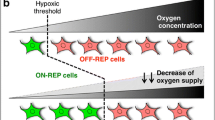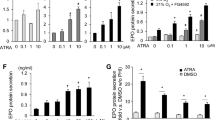Abstract
Purpose
Erythropoietin (EPO) is mainly synthesized within renal peritubular fibroblasts, and also other tissues such as the liver possess the ability. However, to what extent non-kidney produced EPO contributes to the hypoxia-induced increase in circulating EPO in adult humans remains unclear.
Methods
We aimed to quantify this by assessing the distribution of EPO glycoforms which are characterized by posttranslational glycosylation patterns specific to the synthesizing cell. The analysis was performed on samples obtained in seven healthy volunteers before, during and after 1 month of sojourn at 3,454 m altitude.
Results
Umbilical cord (UC) plasma served as control. As expected a peak (p < 0.05) in urine (2.3 ± 0.5-fold) and plasma (3.3 ± 0.5-fold) EPO was observed on day 1 of high-altitude exposure, and thereafter the concentration decreased for the urine sample obtained after 26 days at altitude, but remained elevated (p < 0.05) by 1.5 ± 0.2-fold above the initial sea level value for the plasma sample. The EPO glycoform heterogeneity, in the urine samples collected at altitude, did not differ from values at sea level, but were markedly lower (p < 0.05) than the mean percent migrated isoform (PMI) for the umbilical cord samples.
Conclusion
Our studies demonstrate (1) UC samples express a different glycoform distribution as compared to adult humans and hence illustrates the ability to synthesis EPO in non-kidney cells during fetal development (2) as expected hypoxia augments circulating EPO in adults and the predominant source here for remains being kidney derived.



Similar content being viewed by others
Abbreviations
- EPO:
-
Erythropoietin
- Glc-NAc:
-
N-acetylglucosamine
- HA:
-
High altitude
- MAIIA:
-
Membrane-assisted isoform immunoassay
- PMI:
-
Percent migrated isoform
- SL:
-
Sea level
- WGA:
-
Wheat germ agglutinin
- UC:
-
Umbilical cord
References
Abbrecht PH, Malvin RL (1966) Renal production of erythropoietin in the dog. Am J Physiol 210:237–242
Berglund B, Gennser M, ÖRnhagen H, ÖStberg C, Wide L (2002) Erythropoietin concentrations during 10 days of normobaric hypoxia under controlled environmental circumstances. Acta Physiol Scand 174:225–229
Bernaudin M, Bellail A, Marti HH, Yvon A, Vivien D, Duchatelle I, Mackenzie ET, Petit E (2000) Neurons and astrocytes express EPO mRNA: oxygen-sensing mechanisms that involve the redox-state of the brain. Glia 30:271–278
Bernhardt WM, Wiesener MS, Scigalla P, Chou J, Schmieder RE, Günzler V, Eckardt K-U (2010) Inhibition of prolyl hydroxylases increases erythropoietin production in ESRD. J Am Soc Nephrol 21:2151–2156
Dame C, Fahnenstich H, Freitag P, Hofmann D, Abdul-Nour T, Bartmann P, Fandrey J (1998) Erythropoietin mRNA expression in human fetal and neonatal tissue. Blood 92:3218–3225
Fried W (1972) The Liver as a source of extrarenal erythropoietin production. Blood 40:671–677
Haase VH (2010) Hypoxic regulation of erythropoiesis and iron metabolism. Am J Physiol Renal Physiol 299:F1–F13
Jelkmann W (1992) Erythropoietin: structure, control of production, and function. Physiol Rev 72:449–489
Kapitsinou PP, Liu Q, Unger TL, Rha J, Davidoff O, Keith B, Epstein JA, Moores SL, Erickson-Miller CL, Haase VH (2010) Hepatic HIF-2 regulates erythropoietic responses to hypoxia in renal anemia. Blood 116:3039–3048
Lönnberg M, Lundby C (2013) Detection of EPO injections using a rapid lateral flow isoform test. Anal Bioanal Chem. doi:10.1007/s00216-013-6997-8
Lönnberg M, Drevin M, Carlsson J (2008) Ultra-sensitive immunochromatographic assay for quantitative determination of erythropoietin. J Immunol Methods 339:236–244
Lönnberg M, Andrén M, Birgegård G, Drevin M, Garle M, Carlsson J (2012a) Rapid detection of erythropoiesis-stimulating agents in urine and serum. Anal Biochem 420:101–114
Lönnberg M, Bondesson U, Cormant F, Garcia P, Bonnaire Y, Carlsson J, Popot M-A, Rollborn N, Råsbo K, Bailly-Chouriberry L (2012b) Detection of recombinant human EPO administered to horses using MAIIA lateral flow isoform test. Anal Bioanal Chem 403:1619–1628
Lönnberg M, Garle M, Lönnberg L, Birgegård G (2013) Patients with anaemia can shift from kidney to liver production of erythropoietin as shown by glycoform analysis. J Pharm Biomed Anal 81–82:187–192
Lundby C, Thomsen JJ, Boushel R, Koskolou M, Warberg J, Calbet JAL, Robach P (2007) Erythropoietin treatment elevates haemoglobin concentration by increasing red cell volume and depressing plasma volume. J Physiol 578:309–314
Masuda S, Okano M, Yamagishi K, Nagao M, Ueda M, Sasaki R (1994) A novel site of erythropoietin production. Oxygen-dependent production in cultured rat astrocytes. J Biol Chem 269:19488–19493
Minamishima YA, Kaelin WG (2010) Reactivation of hepatic EPO synthesis in mice after PHD loss. Science 329:407
Mirand EA, Murphy GP, Steeves RA, Weber HW, RF P (1968) Extra-renal production of erythropoietin in man. Acta Hemaat (Basel) 39:359
Mørkeberg J, Sharpe K, Karstoft K, Ashenden MJ (2013) Detection of microdoses of rhEPO with the MAIIA test. Scand J Med Sci Sports. doi:10.1111/sms.12049
Ohls RK (2002) Erythropoietin and hypoxia inducible factor-1 expression in the mid-trimester human fetus. Acta Paediatr Suppl 91:27–30
Olsen NV, Aachmann-Andersen NJ, Oturai P, Andersen TM, Rasmussen AB, Hulston C, Holstein-Rathlou N-H, Robach P, Lundby C (2011) Recombinant human erythropoietin in humans down-regulates proximal renal tubular reabsorption and causes a fall in glomerular filtration rate. J Physiol 15:1273–1281
Rasmussen P, Nordsborg N, Taudorf S, Sørensen H, Berg RMG, Jacobs RA, Bailey DM, Olsen NV, Secher NH, Møller K, Lundby C (2012) Brain and skin do not contribute to the systemic rise in erythropoietin during acute hypoxia in humans. FASEB J 26:1831–1834
Robach P, Cairo G, Gelfi C, Bernuzzi F, Pilegaard H, Vigano A, Santambrogio P, Cerretelli P, Calbet JAL, Moutereau S, Lundby C (2007) Strong iron demand during hypoxia-induced erythropoiesis is associated with down-regulation of iron-related proteins and myoglobin in human skeletal muscle. Blood 109:4724–4731
Siebenmann C, Robach P, Jacobs RA, Rasmussen P, Nordsborg N, Diaz V, Christ A, Olsen NV, Maggiorini M, Lundby C (2012) “Live high-train low” using normobaric hypoxia: a double-blinded, placebo-controlled study. J Appl Physiol 112:106–117
Weidemann A, Kerdiles YM, Knaup KX, Rafie CA, Boutin AT, Stockmann C, Takeda N, Scadeng M, Shih AY, Haase VH, Simon MC, Kleinfeld D, Johnson RS (2009) The glial cell response is an essential component of hypoxia-induced erythropoiesis in mice. J Clin Invest 119:3373–3383
Wide L, Bengtsson C (1990) Molecular charge heterogeneity of human serum erythropoietin. Br J Haematol 76:121–127
Conflict of interest
The authors declare not to have any conflict of interest with regard to the study.
Author information
Authors and Affiliations
Corresponding author
Additional information
Communicated by Guido Ferretti.
Rights and permissions
About this article
Cite this article
Lundby, AK.M., Keiser, S., Siebenmann, C. et al. Kidney-synthesized erythropoietin is the main source for the hypoxia-induced increase in plasma erythropoietin in adult humans. Eur J Appl Physiol 114, 1107–1111 (2014). https://doi.org/10.1007/s00421-014-2844-7
Received:
Accepted:
Published:
Issue Date:
DOI: https://doi.org/10.1007/s00421-014-2844-7




